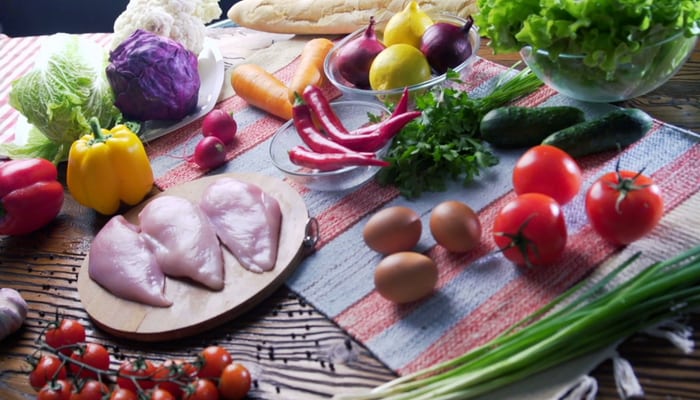We love it when our clients share with us wonderful recipes and other great ideas. If you have something to share, please tell us.
Mouth-watering recipes
Bernadette Magee shared with us recipes for a fabulous, foolproof sour dough bread and a nori wrapped salmon with wasabi mash.
According to Bernadette “This salmon one is delicious, impressive and easy. If the wasabi flavour might be too much, just leave it out.”
Regarding the sour dough she told us “It looks like a lot of work written down, but the video makes it clearer. It’s not that much actual time, but you have to be there to do things at the right time.”
Nori-wrapped salmon with wasabi mash
Ingredients
- 4 x 180g (6 oz) salmon fillets cracked black pepper
- 1 sheet nori, quartered
- 1 tablespoon vegetable oil 80g (21h oz) butter, melted wasabi mash
- 1kg (2 lb) boiling potatoes, peeled and chopped 30g ( I oz) butter
- 1 tablespoon wasabi paste
- 1 cup sour cream
- 2-3 tablespoons milk sea salt
To make the mash, place the potatoes in a saucepan of cold salted water and bring to the boil. Cook until tender when tested with a skewer: Drain and return to the warm pan.
Add the butter, wasabi, sour cream and milk and mash until smooth. Stir through the salt, cover and keep warm.
To cook the salmon, sprinkle each fillet with pepper and wrap in a piece of nori. Heat a frying pan over high heat. Add the oil and salmon and cook, skin side down, for 3 minutes. Turn and cook for a further minute or until just cooked through.
To serve, place the mash on plates, top with the salmon fillets and spoon over the melted butter. Serve with lemon wedges and steamed green vegetables. Serves 4.
Some advice from Bernadette: This salmon one is delicious, impressive and easy. If the wasabi flavour might be too much, just leave it out. Prepare the potato first, as the salmon is so quick to cook.
If the salmon has a thin section on the end, position it in the pan so the thin part goes up the side of the pan, off the direct heat, about half way through the cooking time so it doesn’t overcook.
I usually wash and slice some baby bok choi for greens, and toss them in the pan with the fish and splash a little soy sauce or sesame oil or olive oil on them.
Fool proof Sourdough Bread Recipe
Learning how to make sourdough bread doesn’t have to be stressful, frustrating, time-consuming or overwhelming. Instead, I think it’s a great way to relax and enjoy the process while learning a very valuable, long-lost skill of making authentic sourdough bread.
The main principle to remember is that it’s better to underproof a little than to overproof because over proofed sourdough yields bread as hard and flat as a brick.
These instructions will help you achieve the most perfect crust with a heavenly open crumb.
Ingredients
- 200g sourdough starter (read below for more details)
- 680 + 50g of water – not tap water, the starter doesn’t like chlorine. (use it at 34°C/95°F to speed up the fermentation process)
- 900g strong bread flour, also called hard flour. It is important because it has higher gluten than standard flour, which gives more stretch and spring in the dough.
- 100g whole-wheat flour, or wholemeal spelt flour.
- 24g fine sea salt
Notes about flour:
- If the holes in the cooked loaf are too big, add a bit more wholegrain flour, which will make the bread denser and the holes will be smaller. Another good combination is white, whole wheat and rye.
This recipe is adapted from a fantastic book called Tartine Bread. You can read more about it [here].
Method
On baking day, I prepare my sourdough starter by discarding everything but one tablespoon of an old, fully mature starter. I add 200g of water and whisk until the starter gets dissolved.
Then I add 200g of flour – equal amounts of white wheat flour (all purpose or strong bread flour) and whole wheat flour. I mix everything well and leave to ferment on my counter top.
For this recipe, it’s very important not to over-ferment the starter. When it grows by around 20-30% (definitely no more than 50%), it’s ready to be used.
This will allow the yeast to dominate over the lactic bacteria in the sourdough and will give your bread lots of oven spring, airy texture, and mild, European flavour.
Notes re starter:
- A general rule is 200g of starter for 1000g of flour, so 20%. But it’s not a rule set in stone. In fact, nothing is in sourdough baking. Everything can be adjusted to suit your own schedule or taste.
- You would use more starter if your house was really cold or if you wanted to speed up the fermentation for some reason.
- You could use less if your house was hot or if you wanted to extend the fermentation, let’s say overnight.
- I would start with a standard 20% and then experiment with it when you get a bit more practice and confidence.
- For the amount of water, whole grain flours are more thirsty than refined white flours, so the former will need more water.
- Rye ferments much faster than wheat or spelt.
- Wholegrain flours ferment faster than white flours. The exact amounts and times are for you to experiment with.
Mixing Up the Dough
- Add 200g of recently fed (according to the instructions above) starter to a large mixing bowl.
- Next, add 680g of warm water (or cold if it’s very hot where you live or if you don’t mind waiting for longer). I like using warm water because it speeds up the fermentation and suits my schedule better, but feel free to experiment to find what suits you best. If you do use warm water, make sure it’s not hotter than 34°C/95°F because higher temperatures will start having an adverse effect on the yeast and the flavour.
- Whisk the starter in the water until it’s all dissolved.
- Next, add 900g of strong bread flour and 100 of whole-wheat flour.
- Mix roughly using a Dutch whisk and even your hand if it becomes too difficult to use a whisk. Just dampen your hand and the dough won’t stick as much. Make sure there is no loose flour anywhere on the sides or the bottom of the bowl and you’re good to go.
- Cover the dough and leave to rest for 30 minutes. This step will give enough time for the flour to absorb all the water, which means less kneading and better texture.
Second Hydration and Kneading
Next step is adding 24g of fine sea salt and the remaining 50g of water. The water is needed to make sure that the salt gets distributed throughout evenly and to improve the texture even more.
Knead using pincer and stretch & fold methods until all the water is absorbed and the dough is very soft, smooth, and extremely elastic. It will feel amazing! It takes me around 5 minutes to get to that point, but if you’re just starting out with baking, it might take you up to 10 minutes. If you have no idea what these kneading methods look like, watch a recipe in action [here].
Next step is repeating one set of stretch & fold every 30 minutes, which is four times over the next two hours.
Beyond the first two hours, you’ll need to be very careful not to deflate the dough and stretch & fold gently once every 60 minutes or so until you feel that the dough is ready for shaping (but you can also skip doing it beyond the first two hours, I do it because I feel that it improves my bread and also because it makes it very clear when the dough is ready for shaping). Generally don’t fold beyond 4-5 times, unless it’s cool and slow progressing, and it might help to judge if it’s airy enough to start shaping. It will feel like a cushion. Volume wise, it will have grown by 20-30%. It’s very important not to overproof it. I really can’t stress it enough!
As you can see, I’m not mentioning times because they will depend on the temperature in your house.
The secret is to follow the dough and to get to know the texture, the smell, and the look. You’ll know when it’s ready for the next step.
Pre-Shaping and Bench Rest
Gently scoop out the dough using your hand. Make sure not to disturb the gluten strands of the sourdough too much.
Flour the surface of the dough and divide in into two equal pieces with a dough cutter.
Flip each peace, so that the floured side ends up on the work surface. Fold it in half and then pre-shape it to a tight boule (again, you can watch the video I added above to see how I pre-shape the dough). It doesn’t have to be perfect. It’s just to introduce a little bit of tension to the surface.
Do the same with the second piece.
Flour the surface of each piece lightly and cover with a towel. Leave to rest for 30 minutes.
Final Shaping
Take your bannetons and sprinkle them generously with a mixture of white wheat flour and rice flour. I first sprinkle one and then the other because I’m too lazy to mix them together, and it still works very well.
Be generous with the flour or the bread will stick, and trust me, it’s really not fun!
Flour the surface of the first boule, flip it, flatten it a little bit into a sort of a rectangular shape and then stretch one side and fold over. Stretch the opposite side and fold over. Do the same with the remaining two sides. You’ll end up with a tight, cute parcel.
Flip it and start rolling it to create more tension on all sides (again, you can watch the video to see exactly how). Use your thumb and the other fingers to push from the bottom. This will create palpable tension on the surface of the loaf. You’ll feel it!
Once it’s nice and tight, place it in the banneton seam side up.
Do the same with the second loaf.
Final Proofing
Place both bannetons in plastic bags and retard in the fridge until the next morning. For me, it’s around 12 hours. It suits my schedule because I like having fresh bread for breakfast. But if it suits you better, you can proof it at room temperature for 2-4 hours depending on your room temperature.
The dough can go straight into the oven from the fridge without having to go back to room temperature. Others suggested leaving it on the counter for an hour before baking.
The proofing is done both during stretch and folds and after shaping. It happens in the fridge too, but slower. If it’s over-proofed, the dough will be sticky and will not want to hold any shape at all.
Baking Sourdough Bread
Switch the oven on at the maximum temperature (most ovens go up to 260°C/500°F) and place the Dutch oven inside to preheat for 20 minutes. The Dutch oven, a big cast iron pot with lid, is to keep the moisture around the dough when it goes in the oven, delaying formation of the crust and allowing opportunity for the dough to rise. Alternatives to a Dutch oven are a clay baker with lid, seen [here].
Or a pizza stone with an oven-proof metal lid over the dough. Even a disposable aluminium cooking tray that fits neatly over the pizza stone and is high enough would work.
Keep the second loaf in the fridge while the first is baking.
Once the time is up, take the Dutch oven out and sprinkle some flour on the bottom.
Take the first banneton out of the fridge and drop the loaf carefully into the Dutch oven. Don’t worry if it falls in awkwardly like mine did. The bread will still look great.
Slash the top with a sharp razor or a very sharp and thin knife. I either make three parallel cuts or I draw a square. Don’t make the cuts too deep but don’t cut too lightly either. The feeling will come with practice and the bread will still look and feel great regardless, so just be patient and enjoy the learning process.
Cover the lid, put the Dutch oven back in the oven, reduce the temperature to 230°C/450°F, and bake for 20 minutes.
Once the time is up, remove the lid and keep baking for 20-22 more minutes. Just watch it and when you’re happy with the colour of the crust, it will be ready. It should be deep caramel golden.
Voila! The sourdough bread is ready. Now it’s time to bake the second one. But first, you have to re-heat the oven and the Dutch oven. Place it in the oven, increase the temperature back to 260°C/500°F, and wait for 10 minutes.
Then take the Dutch oven out and bake the second loaf in exactly the same way as you did the first one.
That’s it! You’re now a competent and successful sourdough baker!
Timings and How to Adjust Them
- The temperature is 24-25 C in my apartment.
- I feed the starter at around 9AM.
- I mix up the dough at 3-4PM.
- I bulk ferment it until 8-9PM.
- I then shape it and place it in the fridge for around 12 hours, until the next morning.
- I have fresh bread for around 9-11AM the next morning. If it’s warmer in your home, you’ll need less time. If it’s colder, you’ll need more time.
- If you want the process to be faster, don’t retard in the fridge.
- If you want to slow it down to suit your schedule, place it in the fridge.
- You can reduce the temperature in your fridge to slow down the fermentation even more.
- You can also reduce the amount of sourdough starter to reduce the speed of fermentation.
There are so many ways you can play around with the times, that’s why providing clear cut times wouldn’t be useful. If you focus on what the dough looks like and feels like, you’ll be able to develop your own perfect timings.
When you’re experimenting, always write down the temperature, all the times, quantities of the ingredients used, etc. So that you can look back and improve or repeat your successes.
Never follow the times blindly
Possible Alternative time sequences; To avoid being in the kitchen late at night, 9pm, or getting up in the middle of the night to start the starter.
1. What you can do is feed the starter just before going to bed at night. Mix up the dough the next morning. You should be able to shape the bread late afternoon or early evening and then bake the same evening.
2. Or otherwise you can feed the starter in the morning, then mix up the dough that same afternoon/evening and then depending on your temperature and how fast things are progressing, you can either :
- complete the 3-4 stretch and folds and then place the dough in the fridge overnight and then shape the next morning or
- shape in the evening and then leave the dough in the bannetons overnight and then bake in the morning. The combinations are endless really. You really don’t need to get up in the middle of the night.
- Also, you can make things faster by using warm water and/or a little bit more sourdough starter.
3. After bulk fermentation you can either put it in the fridge overnight or proof them in bannetons for 2-4 hours at room temperature before baking. It depends on your schedule and convenience and room temperature.
4. Storage of loaves if you bake two and only need one. Store in the freezer. Keep half out in a plastic bag. The other three halves freeze and take each out when needed.
Macadamia nut truffle to die for
Heather Woods has told us that these are only to be made at Christmas but there is a very good chance that we may not be able to follow that rule.
We found this advice on the recipe from Heather particularly insightful
“They do not last long. Eat too much and they can affect your thinking processes and co-ordination.”
Ingredients (makes about 40)
- 400g can NESTLÉ Sweetened Condensed Milk
- 30g butter
- 2 tbspn golden syrup
- 2—3 tbspn Kahlua liquer [You can be a bit more generous]
- 200g Macadamia nuts, chopped
- 3½ cups cake crumbs [I prefer Madeira cake]
- 30g Copha, white vegetable shortening
- 200g NESTLÉ Cooking Chocolate [milk, dark or white]
[The above amounts can vary according to personal taste]
Equipment
- 1 small pan
- 1 large mixing bowl
- 1 small bowl
- Large Spoon, a teaspoon, knife
- Alfoil & Cling film
- Shallow Baking trays covered with foil
- Disposable gloves [you will need more than one pair]
Method
Crumb cake, measure out 3½ cups and chop the nuts, mix them together in a bowl.
Combine sweetened condensed milk, butter and golden syrup in a pan, cook gently for approx. 8 mins, stirring constantly over a low heat, until golden. Add Kahlua to the mixture and stir well. Have a drink….
Add golden mixture to the crumbs and nuts. Stir mixture well to ensure all cake crumbs coated with the liquid.
Refrigerate for at least 60 mins. [You can cheat and put the mixture in the freezer.]
Make ready the trays by covering with foil. If you have a freezer make room for the baking trays—to freeze the truffles after the next stage. If no space use your refrigerator
Using the teaspoon as the measure, make balls of the nut mixture and place on the tray.
Put the trays in the freezer or refrigerator. [can be left overnight]
Melt together Copha and NESTLÉ cooking chocolate, [I use the microwave on Medium until copha melted and chocolate almost melted]
Cool slightly, then put on the gloves and dip the frozen truffles into the chocolate. Put them back on the tray and refrigerate until set or refreeze.
Decorate how you wish. I usually make a selection of milk, dark and white chocolate covered truffles. Sometimes drizzling with a contrasting chocolate.
They do keep well in a Tupperware container in the freezer. You can either eat them at room temperature or frozen.








Leave A Comment